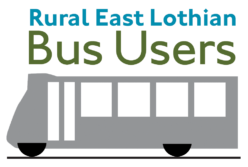 We held our AGM last week, at which our chair, Barry Turner, summarised succinctly a fairly busy year behind us. Our minutes of meetings are published on this website, so feel free to swing by.
We held our AGM last week, at which our chair, Barry Turner, summarised succinctly a fairly busy year behind us. Our minutes of meetings are published on this website, so feel free to swing by.
The highpoint of the meeting was a thoughtful and entertaining talk by public transport expert Barry Hutton, Chartered Town and Transport Planner and also a resident of Pencaitland. His book Planning Sustainable Transport was published earlier this year.
Hutton proposes that public transport must have one or more defined explicit purposes to overcome its inherent unattractiveness (e.g. it is inherently less convenient and less comfortable than the alternatives; it can never be ready and waiting at your door; it can only be delivered at times and places which are not exactly as you wish; AND you can never choose your travelling companions!).
These purposes are:
- To provide mobility for the economically, physically or legally less abled
- To protect the environment, notably by the reduction of CO2
- As a tool of urban planning
While not dismissing the first 2 propositions, basically social and environmental arguments, he dwelt on the power of the third to deliver substantial economic benefits, while meeting the objectives of the other 2 – if indirectly. He posited:
Areas of dense development and activity can only function economically if supported by good quality public transport.
In the case of Central London well over 90% of people use public transport to get there with the implication that this is helping to concentrate significant wealth there, while weakening the argument that public transport is somehow an option of the last resort, which has developed over the last 30 years. But public transport almost everywhere else has eroded over time, so what has happened? As economic activity has shifted, the economic benefits have subsided, while transport policies have been skewed towards the private motor car. Rejecting public transport as inadequate, people use their cars instead, precipitating growing parking problems on the one hand and congestion on the other.
By relocating to places where sufficient parking may be provided, in the main suburban or peripheral brown- or green-field sites, companies have encouraged an opposite shift. This has done much to resolve congestion but coincidentally and has done so at the cost of decentralisation, dispersal and a financial weakening of city and town centres. The changing social geography has also loosened the weave of the urban fabric, where people increasingly no longer want to live, driving the urbanisation of the countryside and impoverishing our city centres and towns. Pick up this weeks ESPC and see what the editors are recommending is the best place to live? Clue: not in town.
So the argument goes that a vital public transport and associated infrastructure underpins the financial health and continued existence of businesses in urban centres and, protects the countryside from the onward march of urbanisation; and it resolves congestion and parking problems; it also reduces social and economic divisions and abates environmental impacts all at the same time. The geometry of urban living dictates less cars, there simply isn’t the space, and our already populous island can never accomodate the seemingly ever growing demand for an illusory suburban paradise.
He concluded with this reflection:
The ‘benefits’ of public transport should not to be measured by ticket revenue but by their effect upon land values, council tax yields, gross value added etc.
Which seems to us to be a strong argument not just for “better regulation” of public transport, which underpins Iain Gray’s Bus Bill Consultation, but for better transport planning policies and far better implementation.
